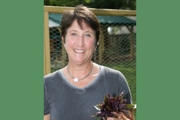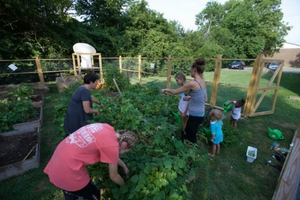Reframe Podcast: Episode 17

New Oxford Community Garden Plants Seeds of Change

In this episode, we talk with Beth Miller, an assistant professor of Nutrition and Dietetics, and a founding member of the Institute for Food, where she helps people gain access to healthy foods by linking together Miami's organic farm, the local food pantry, and various community gardening initiatives.
James Loy:
This is Reframe, The podcast from the College of Education, Health and Society on the campus of Miami university.
In this episode, we talk with Beth Miller, an assistant professor of Nutrition and Dietetics, and a founding member of the Institute for Food, where she helps people gain access to healthy foods by linking together Miami’s organic farm, the local food pantry, and various community gardening initiatives.
So, Dr. Miller, thank you for being here. Can you tell us a bit about your research and more about what you study?
Beth Miller:
So the big overarching is . . . I do community based participatory research. And the larger bucket of what I look at is obesity prevention. So looking at ways to prevent obesity in various populations and most of them are marginalized communities, low-income populations. Ethnicities. Hispanic populations. And African America. And looking at health disparities. So those folks that fall into those categories generally are the ones that have those health disparities.
So community based research is essentially where you are partnering with the communities to help them solve problems that they think are important. And that they find a need to create a solution for. So we are in a partnership so we can work together. I obviously know research. I have something to bring to the table to help them facilitate the process. But I need them to help me understand the issues, to have access to a better understanding of the circumstance. So it is this working together.
What I love about it is it is truly the translation of research. That is the piece that do. It’s that translation in to a real-world community, into a real-world population. Let’s see what kind of behavior change can happen through education, through skills development, capacity building to have them facilitate the change.
James Loy:
So it is not just knowledge that goes into an academic journal and just sort of stays there forever. It is that bridge that actually brings that knowledge into a real world situation or a setting.
Beth Miller:
Right. And the other exciting part is that we have this co-creation of knowledge. So I know what I know through what I’ve learned through academic journals, books, my experience. But the community has their own sense of knowledge about what will work in their community, how their community functions. So we bring those together to make it work.
James Loy:
And what are some of the factors that could be different from one community to the next? Or maybe even some factors that you wouldn’t think would make a difference but actually do?
Beth Miller:
Well, it could be the actual geographic location of the community. So what’s in the community. What environmental stressors are there? What things like grocery stores are near? You might have some communities that have more access to those types of things. Green space. And then the capacity of the community. Some communities have . . . you find that you have really engaged and folks living there who want to help and want to be participants. And then other times you have people who are less engaged. So just the dynamics of the people living there, that make up the community, can make a whole different ballgame.
James Loy:
And what is it about low income families that actually does lead to unhealthy lifestyles? I know we have heard a lot about that connection, anecdotally maybe. But can you just spell it out for us? What is it that they struggle with in regard to being healthy, when a family might be low income?
Beth Miller:
Well, one is the actual limitations of budget. So it is challenging and there are a lot of factors and a lot of knowledge expectations and assumptions that are made about being able to work and eat healthy on a very small budget. And then you layer on top of that access to healthy foods. Often times in lower income communities you don’t have nice grocery stores. You have corner markets where you might have some fruit and vegetables options kind of sitting on the counter, but very few and it is probably not the most appealing produce. So you have more of the high fat, high salt, high sugar types of foods that are cheap.
And so we have these commodities, these types of foods that are cheap. You can buy really cheap frozen dinners. You can buy soda for 99 cents a two liter versus a gallon of milk. So these economics start to factor into part of that picture. Education, transportation to the grocery stores. A lot of times people have to take the bus to get to the grocery store. They might have three kids they are trying to take on the bus to the grocery store. There are a lot of barriers to getting there and actually having the value of what that healthy food is.
Some of the work that we’ve done with, for example, in Head Start, we ask these questions of the mothers that we worked with and they said that often times, “We are so stressed about whether our water is going to get shut off, whether we are going to have enough money for rent . . .” That when you think about nutrition, it is not just nutrition. They are more concerned about having food to put into their child’s belly. They don’t really . . . in a perfect world they would care about what that food was. But it is just do I have something that can fill the void. And that becomes lower on their priority list when they are worried about all these other things. That survival.
James Loy:
Are there some things that people can do to help . . . I mean, in general even if you don’t know the specific situation of a family or where they live in particular, what are some things that you can tell people to do to improve their situation or that could help if they are struggling in various ways?
Beth Miller:
Well, one of the things is to be knowledgeable about other services. . . So in that example of the woman that I use, if she has young children, she is on food stamps and the kids can get free meals in school. The preschooler can have access to a preschool that includes meals. You have WIC, the Woman’s and Infants and Children’s program, that provides health food like a debit card where they can buy orange juice and cheese and cereal and milk. So it is knowing how what resources that would help them access healthier foods. And then also doing shopping tours with how do you shop on a budget. So educating them on here’s how we can make choices on a budget and have some healthier options.
James Loy:
Is part of it too about maybe switching their perspective on what eating healthy actually means? Because I feel like processed foods are so ubiquitous. They are just everywhere. I think a lot of people don’t even realize how unhealthy certain processed foods can be. Or is it about educating them on why they should choose one certain type of food over another?
Beth Miller:
Right. And to complicate that sometimes. So the fruits usually are not a problem. Some of the vegetables if you are refrigerating, you know, we have another factor of sometimes they don’t have refrigeration. Sometimes they don’t have a full stove. They are working with a microwave or a toaster oven. And that is the kind of equipment they have to do cooking with. So, again, some of those are other factors that factor into what these meals are like. What kind of food is prepared? And why people go toward processed food that are ready to eat rather than having to be prepared.
James Loy:
I feel like . . . yeah, if there is one thing that constantly trips me up it is the convenience factor. I mean, we’re so busy throughout the day that it is so easy to grab something processed or fast food or whatever it may be.
Beth Miller:
Yeah, and it becomes that shift in wanting to do something different and making the healthy choice an easier choice. That is important. If we want people to eat healthy it also has to be easy and convenient as well.
James Loy:
That sounds almost like it would be . . . it might take a whole change in the way the system works. Even a deeper cultural change.
Beth Miller:
And they do have programs set up. So retailers that are in low income communities that have programs where they are incentivized to offer more fresh produce at a lower price than some of the other options, and then they are subsidized for that and they are provided incentives so that they don’t lose money trying to carry these healthier foods. Because that is the problem too. If you look at the small business person in these communities, they will say, well, this is what sells. So you can have them promote healthier foods at a cheaper price, then it starts to create that shift a little bit.

